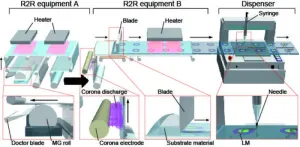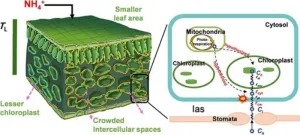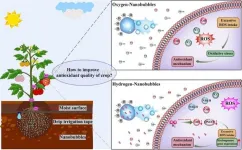(Press-News.org) Researchers from Drexel’s College of Medicine have identified new drugs that show early success in shrinking breast cancer tumors that have metastasized in the brain. The discovery marks the first time that targeting a key metabolic enzyme in cancer cells in the brain has shrunk tumors in a mouse model. The findings, which could develop into more effective therapies for breast cancer brain metastases, were recently published in the journal Frontiers in Pharmacology.
Brain tumor growth depends on converting an energy source for the brain known as acetate, to acetyl-CoA — a molecule involved in biochemical reactions in carbohydrates, proteins and in metabolism and that aids in energy production — using an enzyme known as acetyl-CoA synthetase 2, or ACSS2.
With this knowledge, the Drexel team used computer models to identify stable drug compounds that can break through the blood-brain barrier — a major obstacle plaguing many existing drug options for cancer patients — bind to ACSS2, block its function and shrink tumors in the brain.
“Currently available inhibitors aren’t very good, or don’t get to the brain,” said senior author Mauricio Reginato, PhD, a professor and chair of the department of Biochemistry & Molecular Biology in the College of Medicine. “This work is still in very early stages, but we’re finding that these novel compounds are crossing the blood-brain barrier and effectively starving tumors of a key energy source.”
In the lab, the compounds, known as AD-5584 and AD-8007, selectively killed cancer cells and blocked tumor growth in animal models, as well as reduced acetyl-CoA and lipids that cancer cells depend on for survival and growth.
“Our predictive computational models helped us identify two ACSS2 inhibitors that exhibited stability and important drug-like properties from a pool of other molecules,” said senior author Alexej Dick, MBA, PhD, an assistant professor in the College of Medicine. “We could verify our computational pipeline's success and predictive power in the lab and saw a good correlation with our predictions. This is critical and very helpful for further developing those drugs into a clinically relevant range.”
Reginato, who is also Program Leader of the Translational and Cellular Oncology Program at the Sidney Kimmel Cancer Center Research Consortium, reached out to Nicole Simone, MD, a professor and radiation oncologist at Thomas Jefferson University’s Sidney Kimmel Cancer Center, to test the combination of these inhibitors with radiation in brain slices containing cancer cells. The colleagues found that the inhibitors work well in concert with radiation to both destroy tumors and block tumor growth.
About 10-15% of stage IV breast cancer patients develop brain metastasis, a term used when cancer cells spread into the brain, and more than eight out of 10 patients with brain metastasis are diagnosed with end-stage disease within a year following their diagnosis.
Treating these growths through surgery, radiation and/or chemotherapy can damage healthy brain tissue and doesn’t destroy the tumor entirely. Aside from a few chemotherapy drugs, there are few effective cancer drugs that can cross the blood-brain barrier. This same barrier of blood vessels and tissue that protects a healthy brain from infection-causing bacteria is also the largely impenetrable obstacle for existing cancer-fighting drugs.
The authors are working on optimizing these compounds with the hopes of running a clinical trial in patients in the next few years to determine possible toxicities of these new ACSS2 inhibitors, proper dosing, and see if using this drug allows patients to use less radiation. The research team currently holds a patent, is in pursuit of another for newer compounds and is exploring the creation of a startup to further develop the inhibitors.
In 2022, 42,211 women died from breast cancer, according to the Centers for Disease Control and Prevention. One in eight women will develop breast cancer, according to the National Breast Cancer Foundation.
The current work builds on earlier research from Reginato and colleagues on the critical role for this ACSS2 protein for tumors in the brain.
“We knew these drugs were killing the cancer cells, but the mechanism we discovered was quite exciting,” said Reginato. “It’s causing ferroptosis, a relatively new form of cell death, discovered only about a decade ago, and causes damage to the membrane of a cell, causing it to leak everything out and cause an immune response. The immune cells see the contents of the cell leaking out and any drug that causes this type of cell death and immune response may also sensitize to radiation or immune therapy.”
Currently available FDA-approved immune therapy works well in “hot” cancers, thanks to antigens on the surface of the cancer cells that make it easier for immune cells to recognize and attack tumors. In contrast, “cold” cancers prevent immune cells from entering tumors, so adding these drugs could someday fulfill a critical need in breast and other cancers.
“We are currently planning to test whether these new drugs can turn breast cancer brain metastasis into a ‘hot’ tumor and thus synergize with immune therapy and radiation in preclinical models,” Reginato said.
In addition to Reginato and Dick, additional authors on the paper include lead author Emily M. Esquea, Lorela Ciraku, Riley G. Young, Jessica Merzy, Alexandra N. Talarico, Nusaiba N. Ahmed, Mangalam Karuppiah, Anna Ramesh, Adel A. Rashad, Simon Cocklin and Joris Beld from Drexel, Adam Chatoff, Claudia V. Crispim, and Nathaniel W. Snyder from Temple University and Nicole L. Simone from Thomas Jefferson University’s Sydney Kimmel Cancer Center.
The study, “Selective and brain-penetrant ACSS2 inhibitors target breast cancer brain metastatic cells,” was supported by National Institutes of Health (NIH) grants R01CA259111 and R01GM132261, UO1CA244303, UO1CA244303, R01CA259111 and
R01GM132261, as well as support from the Pennsylvania Breast Cancer Coalition and a Coulter-Drexel Translational Research Award.
END
Drexel team identifies drug-like molecules that show early success in targeting breast cancer brain metastases
2024-07-18
ELSE PRESS RELEASES FROM THIS DATE:
Archivist explores Troy's invisible workers
2024-07-18
While poring over nearly century-old photos documenting the University of Cincinnati’s historic excavation at Troy, archivist Jeff Kramer was struck by just how many people worked behind the scenes for years to contribute to its success.
The archivist and research associate in UC’s Department of Classics created a digital archive of pictures and documents from UC archaeologist Carl Blegen’s influential 1930s project that identified nine periods of reconstruction and evidence of a great battle and fiery devastation that some historians said was suggestive of the ransacking of Troy.
But ...
Stretchable electronics might make their way onto the market thanks to roll-to-roll process
2024-07-18
Electronics have evolved over the years to supersede simply enhancing day-to-day life to becoming almost seamlessly integrated with daily life. People have become accustomed to wearable electronics, but what about stretchable ones? There is a growing demand for this type of technology, but the current methods are not easily scalable for mass production to make these devices available to the public. However, mass development may be possible using the roll-to-roll (R2R) process, which prints various layers on a flexible rolled substrate, cutting out the manual nature of the process. By rolling this type of electronic out into the market, the possibility for stretchable electronics and even ...
From roots to leaves: The nitrogen connection to photosynthetic efficiency
2024-07-18
Delving into the nuances of plant nutrition, researchers have discovered that the form of nitrogen intake profoundly affects the efficiency of photosynthesis in plants. This pivotal finding sheds light on how plants process and utilize nitrogen, offering critical insights for enhancing crop productivity and optimizing nitrogen use in agriculture.
Photosynthesis efficiency in plants is influenced by the type of nitrogen absorbed. Ammonium (NH4+) and nitrate (NO3-) are the primary nitrogen sources, each affecting plant physiology differently. Variations in leaf anatomy, such as cell wall thickness and chloroplast number, play a crucial role in ...
Bubbling with benefits: Hydrogen nanobubbles boost tomato antioxidants
2024-07-18
A pioneering study has unlocked the potential of hydrogen nanobubbles to significantly augment the antioxidant content in tomatoes. This innovative irrigation technique not only fortifies the fruit with higher concentrations of health-boosting compounds but also opens new avenues for enhancing the nutritional value of agricultural produce. The research provides a blueprint for leveraging hydrogen's unique properties to combat oxidative stress and promote a healthier diet.
Tomatoes are a key source ...
Engineering: Tool predicts rogue waves up to 5 minutes in advance
2024-07-18
A new tool that can be used to predict the emergence of unusually large and unpredictable waves at sea — known as rogue waves — up to five minutes into the future is presented in a study published in Scientific Reports. The authors suggest that the tool could be used to issue advance warnings to ships and offshore platforms to enable those working on them to seek shelter, perform emergency shutdowns, or manoeuvre to minimise the impacts of approaching rogue waves.
The tool developed by Thomas Breunung and Balakumar Balachandran consists of a neural network that has been trained ...
Social distancing during the COVID-19 pandemic and neonatal mortality in the US
2024-07-18
About The Study: In this population-level study of National Center for Health Statistics databases, neonatal, early neonatal, and infant mortality rates did not increase during the initial COVID-19 pandemic period. However, associations were observed between the pandemic period social distancing measures and higher rates of neonatal and early neonatal mortality, as well as preterm birth rate with a lag period, suggesting the importance of monitoring infant health outcomes following pandemic-related population behavior changes.
Corresponding ...
Changes in registered nurse employment plans and workplace assessments
2024-07-18
About The Study: The results of this study showed that nurses reported improved workplace conditions in the 2023 vs the 2022 survey; however, planned departure rates, abusive or violent events, and unsafe conditions remained high, and understaffing remained a primary concern for most nurses. Health system leaders and policymakers should prioritize initiatives that support nurse retention and reduce potential workforce instability.
Corresponding Author: To contact the corresponding author, Christopher ...
Healthy prenatal dietary pattern and offspring autism
2024-07-18
About The Study: In this cohort study of mother-child dyads, adherence to a healthy prenatal dietary pattern was associated with a lower odds of autism diagnosis and social communication difficulties but not restrictive and repetitive behaviors.
Corresponding Author: To contact the corresponding author, Ruth Dundas, M.Sc., email ruth.dundas@glasgow.ac.uk.
To access the embargoed study: Visit our For The Media website at this link https://media.jamanetwork.com/
(doi:10.1001/jamanetworkopen.2024.22815)
Editor’s Note: Please see the article for additional information, including other authors, author ...
Comparative effectiveness of three digital interventions for adults seeking psychiatric services
2024-07-18
About The Study: The findings of this study suggest that different digital interventions can be used as supplemental or adjunctive tools within health care systems and may support patients during waiting list–related delays in care.
Corresponding Author: To contact the corresponding author, Adam G. Horwitz, Ph.D., email ahor@umich.edu.
To access the embargoed study: Visit our For The Media website at this link https://media.jamanetwork.com/
(doi:10.1001/jamanetworkopen.2024.22115)
Editor’s Note: Please see the article for additional information, including other authors, author contributions and affiliations, conflict of interest and ...
Mental health apps may help those waiting for care, study finds
2024-07-18
The recent surge in people seeking mental health care across the country has led to long wait times for first appointments with therapists and psychiatrists.
Now, a new study offers hope that while they wait to get care, patients could still get some relief by using evidence-based smartphone apps and wearable devices to track sleep and activity.
The study shows that depression and anxiety symptoms, and suicidality, all decreased measurably when patients were assigned to mobile applications that incorporated mindfulness practices, cognitive-behavioral therapy skills, or prompts that encouraged ...



